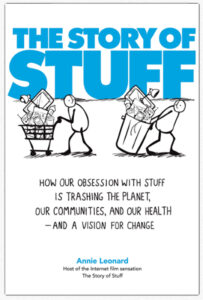Solving the waste crisis starts with understanding the story behind it.
“Out of sight, out of mind” describes the general attitude toward the current waste crisis. Most of us just don’t have to think about our trash much. Not when garbage trucks come and whisk it away on a weekly basis. Disposal fees don’t even account for how much stuff gets tossed. Unlike other utilities, trash service comes at a flat rate.
In fact, each person produces about 4.5 pounds of trash daily. Despite making up only 5 percent of the world’s population, the U.S. is responsible for 30 percent of the world’s waste.
Where does it all come from? Where does it all go?

The Story of Stuff answers these big questions in a brisk twenty-minute video starring the executive director of Greenpeace USA, Annie Leonard. Without mincing words, Leonard describes a bleak timeline that begins with the exploitation of natural resources and ends with consumer leftovers mummified in landfills or burned to ashes by incinerators.
The journey from raw materials to waste is a complicated one. But with the help of animation, Leonard breaks it down in a way that’s entertaining and easy to understand. Teachers have recognized the power of this teaching tool, and they’re showing the video in classrooms around the world.
The statistics alone may shock people into rethinking their consumption and waste habits. And The Story of Stuff is just one of many sources out there serving up important facts. Last month, Newsweek reported that fast-changing fashion is largely responsible for 14 million tons of clothing being trashed every year. And 80 percent of that winds up in landfills.

The good news? We can change the course of these narratives.
One way is to get more use out of the stuff we already have. These days, “waste” defines things that are fully functional but no longer trendy. What hits the market today is deemed obsolete tomorrow.
But there’s no expiration date on perfectly good clothes or electronics that still work well. Most stuff can be recycled. The usual suspects include aluminum cans and bottles made of glass or plastic. But don’t forget paper towels and toilet paper rolls, tissue boxes, aluminum foil, plastic soap dispensers, and all that junk mail. Metal pots, pans and utensils are recyclable too.
Using apps such as GoodGuide and ThinkDirty, shoppers can scan barcodes to determine the greenness of a product. These mobile tools can help you reduce the amount of harmful chemicals that flow back into the environment.—Matt Nelson
